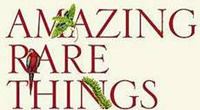Amazing rare things
 Amazing Rare Things: The Art Of Natural History In The Age Of Discovery, an extraordinary exhibition, recently shown in Edinburgh at The Queen’s Gallery, Palace of Holyroodhouse, has been selected from the collections in the Royal Library by Royal Collection curators in collaboration with the distinguished naturalist and broadcaster Sir David Attenborough.
Amazing Rare Things: The Art Of Natural History In The Age Of Discovery, an extraordinary exhibition, recently shown in Edinburgh at The Queen’s Gallery, Palace of Holyroodhouse, has been selected from the collections in the Royal Library by Royal Collection curators in collaboration with the distinguished naturalist and broadcaster Sir David Attenborough. It brings together the works of four artists and a collector who have shaped our knowledge of the world around us. Leonardo da Vinci, Cassiano dal Pozzo, Alexander Marshal, Maria Sibylla Merian and Mark Catesby are diverse figures who shared a passion for enquiry and a fascination with the beautiful and bizarre in nature.
All lived at a time when new species were being discovered around the world in ever increasing numbers. Many of the plants and animals represented in the exhibition were then barely known in Europe. Today some are commonplace, while others are extinct.
A great scientist, as well as a great artist, the Renaissance master Leonardo da Vinci (1452-1519) used drawing to understand all natural forms. He believed that the painter had to comprehend every aspect of creation in order to produce truthful images. Many of Leonardo’s drawings relate to his planned treatises on the human body, the anatomy of the horse and botany, as well as on painting. Leonardo pursued his anatomical investigations through dissection, and the exhibition includes drawings of parts of a cow, horse and bear.
Among a series of delicate plant studies for the foreground of the painting Leda and the swan is the earliest evidence in Italy of the grass ‘Job’s tears’. Leonardo’s profound awareness of the endless cycle and unconscionable timescale of natural processes recurs throughout his writings and is reflected in drawings such as An outcrop of stratified rock.
The Italian antiquarian Cassiano dal Pozzo (1588-1657) embodied the new spirit of empirical investigation that transformed the study of natural history in the 17th century. He belonged to Europe’s first modern scientific academy, the Accademia dei Lincei, which numbered Galileo among its members.
Cassiano’s palazzo in Rome housed a collection of specimens, scientific instruments, a zoo and laboratory, as well as his famous library. He commissioned artists to record plants, birds and animals for his museo cartaceo (paper museum), a pictorial encyclopaedia that attempted to understand and classify both the natural and ‘man-made’ world. The subtleties and variations of nature, whether seen in a dissected porcupine, a three-toed sloth, a misshapen fruit or a fossil, were recorded with the same painstaking scrutiny.
Unique in English 17th-century art, Alexander Marshal’s exquisite florilegium (flower-book) was compiled at a time when the cultivation of gardens had become the absorbing pursuit of scholars and collectors. Marshal (c.1620-82) was part of a circle of leading gardeners, among them John Tradescant the Younger and John Evelyn, who exchanged and traded in botanical specimens.
The pages of his flower-book document the contents of English gardens over the course of a year. Alongside indigenous species sit new and exotic flowers, such as the crown imperial, hyacinth and broken tulip. Marshal’s plant portraits cleverly express the individual character of each subject. Some sheets are embellished with charming miniatures of animals and insects, others with striking trompe-l’oeil creatures; a grass snake slithers beneath a Seville orange, while a dead jay lies at the bottom of a page of delicate anemones and crocuses.
Maria Sibylla Merian (1647-1717) earned her living as a flower painter, teacher and a dealer in paints and pigments in Frankfurt and Amsterdam. Her lifelong fascination with flies, spiders and caterpillars began when she was thirteen. In 1699, at the age of 52, she travelled with her daughter to the Dutch colony of Surinam in South America to study and chronicle the life cycles of moths and butterflies. The resulting publication Metamorphosis insectorum Surinamensium (1705) is one of the most important works of natural history of its era and the first scientific work to be devoted to the area.
From notes, sketches and specimens, Merian produced vibrant watercolours of butterflies and moths in her characteristic style of exuberant curves and spirals. Some of her compositions employ a dramatic narrative, verging on the macabre; a pink-toed tarantula is poised to eat a humming bird and a water bug devours a frog beneath a towering flower.
Mark Catesby’s drawings for his pioneering work, The Natural History of Carolina, Florida and the Bahama Islands, (1729-47), were made during two visits to the east coast of America. A self-taught artist from Suffolk, Catesby (1682-1749) set out to produce a comprehensive survey of the flora and fauna native to this part of the New World. He had two important patrons in the physician-collectors Sir Hans Sloane, founder of the British Museum, and Dr Richard Mead.
On his return to England, Catesby funded the publication by working in the experimental London nurseries of Christopher Gray and Thomas Fairchild, author of the City Gardener. Catesby’s striking watercolour studies were painted in the field: ‘In designing the Plants, I always did them while fresh and just gather’d: And the Animals, particularly the Birds, I painted them while alive…and gave them their Gestures peculiar to every kind of Bird…’.
The exhibition is accompanied by the book Amazing Rare Things: The Art of Natural History in the Age of Discovery by Sir David Attenborough, Susan Owens, Martin Clayton and Rea Alexandratos, published by Royal Collection Publications, exhibition price £9.95.
The Queen’s Gallery, Buckingham Palace: Open daily 10.00–17:30 (last admission 16:30), closed 21 March 2008.
Admission prices (includes Amazing Rare Things, Treasures from the Royal Collection and audio tours): Adult £8.50, Over 60/Student £7.50, Under 17 £4.25, Family (2 adults and 3 under 17s) £21.50, Under 5 free.
Advance tickets from Royalcollection.org.uk.

